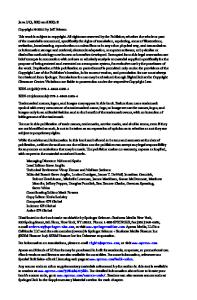Oxygen potentials in Ni + NiO and Ni + Cr 2 O 3 + NiCr 2 O 4 systems
- PDF / 658,523 Bytes
- 6 Pages / 603.28 x 783.28 pts Page_size
- 72 Downloads / 335 Views
(800 -< T--< 1300 K)
and for the coexistence of Ni + CrzO3 + NiCr204, A/xo~(Ni + Cr203 + NiCr204) = -523,190 + 191.07T(+-100)J mol -~
(1100 - T-< 1460 K)
The "third-law" analysis of the present results for Ni + NiO gives the value of AH%8 = -239.8 (+-0.05) kJ mol -~, which is independent of temperature, for the formation of one mole of NiO from its elements. This is in excellent agreement with the calorimetric enthalpy of formation of NiO reported in the literature.
I.
INTRODUCTION
N I C K E L and Cr are the important constituent elements of high-temperature oxidation-resistant alloys. The spinel phases play an important role in the formation of oxide scales on the alloys subjected to oxidizing atmospheres at elevated temperatures. The spinel phases also occur as oxide inclusions in cast metals and in slags employed in the refining of metals by pyrometallurgical processes. Therefore, accurate information on the thermodynamic properties of the spinel phases is required for the correct description of some of the metallurgical reactions involving the formation of these spinel phases. The chemical potential of O for the coexistence of Ni + Cr203 + NiCr204 phases has been measured by Tretjakow and Schmalzriedtu (1000 to 1500 K) by employing the solid-state galvanic cell technique. They used calcia-stabilized zirconia as the solid electrolyte and air at Po2 = 2.125 x 104 Pa as the reference electrode. Davies and Smeltzert21 (1173 to 1373 K) also employed a similar technique for the measurement of O potential corresponding to the Ni + Cr203 + NiCr204 three-phase equilibrium with a twophase mixture of Fe + "FeO" as the reference electrode. Kunnmann et al. t3] (1073 to 1380 K) determined the O potentials for the coexistence of Ni + Cr203 + NiCr204 phases by measuring the equilibrium ratios of CO/CO2 for the reduction of NiCrzO4 to Ni and Cr203. Schaefert41 (1173 to 1260 K) determined the Gibbs energy of formation of NiCr204 over a small temperature range employing an emf technique using Cu + Cu20 two-phase G.M. KALE, Lecturer, and D.J. FRAY, Professor, are with the Department of Mining and Mineral Engineering, University of Leeds, Leeds LS2 9JT, United Kingdom. Manuscript submitted May 17, 1993. METALLURGICAL AND MATERIALS TRANSACTIONS B
mixture as the reference electrode. More recently, KungtS] (1000 to 1300 K) measured the O potentials for Ni + Cr203 + NiCr204 equilibrium employing the solidi state galvanic cell technique. He used yttria-stabilized zirconia as the solid electrolyte and a two-phase mixture of Ni + NiO as the reference electrode. Muller and Kleppat6] measured the enthalpy of formation of NiCr204 from NiO and Cr203, employing solution calorimetry at 1173 K, using 2PbO. B 2 0 3 melt as the solvent. The standard Gibbs energy of formation of NiCr204 from component oxides as a function of temperature, as measured by different investigators, is summarized in Table I. It can be seen clearly that there is a considerable amount of disagreement among the data reported in the literature on the thermodynamic stab
Data Loading...











